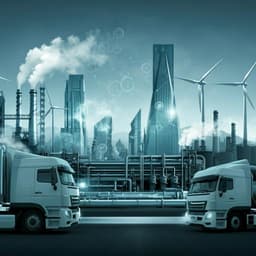
Environmental Studies and Forestry
Reducing sectoral hard-to-abate emissions to limit reliance on carbon dioxide removal
O. Y. Edelenbosch, A. F. Hof, et al.
This research by Oreane Y. Edelenbosch and colleagues explores the critical role of carbon dioxide removal technologies in achieving net-zero greenhouse gas targets, highlighting the potential to reduce emissions in hard-to-abate sectors. Discover how demand and technological interventions could dramatically lower dependence on bioenergy with carbon capture and storage.
~3 min • Beginner • English
Introduction
The study addresses how to achieve net-zero greenhouse gas emissions while reducing dependence on carbon dioxide removal (CDR) by further mitigating residual emissions in hard-to-abate (HtA) sectors: heavy industry, international transport, agriculture (non-CO₂), and buildings. Following the Paris Agreement’s aim to limit warming to 1.5 °C, most scenarios reach net-zero CO₂ around mid-century and net-zero GHG about a decade later. However, integrated assessment scenarios often maintain considerable residual emissions (on average ~11 GtCO₂ yr⁻¹ at net-zero CO₂), compensated by CDR. The HtA sectors are difficult to fully decarbonize due to technical limits, long asset lifetimes, complex value chains, international competitiveness, site-specific constraints, and social acceptance barriers. The research question is whether targeted demand and technology measures in HtA sectors can drive deeper reductions, thereby limiting the scale and risks associated with BECCS and other CDR options while meeting a 1.5 °C pathway.
Literature Review
A comprehensive literature review catalogued barriers to deep mitigation in each HtA sector and identified potential demand-side and technology measures along with policy instruments to overcome them. Barriers include rapidly growing service demand (transport, materials, food), limited near-term technology alternatives (aviation/shipping fuels, process emissions in industry), heterogeneity and slow turnover (buildings), and constrained non-CO₂ mitigation (agriculture). Measures span sustainable fuels, electrification, efficiency, circularity and material efficiency, operational improvements, and lifestyle shifts (diet change, reduced food waste, reduced travel demand). Policy instruments include economic (taxes, subsidies, R&D), regulatory (standards, mandates), and enabling measures (information, infrastructure, voluntary agreements, technology transfer). The review informed the scenario design implemented in the IMAGE framework and is detailed in Supplementary Information and Extended Data Tables 1–5.
Methodology
The analysis uses the IMAGE 3.x integrated assessment framework, which couples energy-industry (TIMER), agriculture-economy (MAGNET), land and earth-system components (LPJmL) and a simple climate model (MAGICC). The model resolves sectoral detail for HtA sectors, land-energy interactions, bioenergy, CCS storage capacity, and regional heterogeneity (26 regions; land at 5×5 min grid). A cost-effective global carbon price pathway is applied to achieve a 1.5 °C-consistent radiative forcing target (1.9 W m⁻² by 2100) in the Reference 1.5 °C scenario (SSP2) and is held constant across variant scenarios for comparability. Four core scenarios are developed under SSP1, SSP2, and SSP3 socioeconomic narratives: (1) Reference 1.5 °C (SSP2, carbon price only); (2) Demand 1.5 °C (same carbon price plus ambitious demand-side measures in HtA sectors); (3) Technology 1.5 °C (same carbon price plus accelerated diffusion and adoption of low-carbon technologies); and (4) Combined 1.5 °C (both demand and technology packages, with overlapping measures harmonized). Demand measures include: aviation demand moderation (telework, local tourism, airline ticket tax, modal shift to high-speed rail), reduced transport expenditure growth, material efficiency leading to ~43.5% lower material demand by 2060 vs 2016 (steel, cement, paper/pulp, chemicals, other industry), building service demand reductions (lower heating/cooling setpoints, reduced appliance ownership, smaller floorspace, higher occupancy), and food system changes (healthy diets for 80% of population by 2050 and 100% by 2100, 40–50% food waste reduction). Technology measures include: rapid electrification and zero-carbon industrial process routes (e.g., hydrogen-direct reduced iron, electric arc furnaces, electrowinning; foreclosure of least-efficient technologies; electrified crackers; CHP preferences; non-fossil energy in paper/pulp), buildings decarbonization (no fossil space heating after 2050, heat pumps, rapid turnover, deep retrofits, rooftop PV), and transport technologies (more efficient, lightweight aircraft; electric aircraft for short-haul; hydrogen-fueled aircraft for short/medium-haul; drop-in biojet fuels; early retirement of conventional planes; operational efficiency). In agriculture, Technology 1.5 °C assumes artificial meat substitution of conventional meat (60% by 2050, 80% by 2100), optimistic non-CO₂ mitigation (e.g., enteric methane inhibitors such as Asparagopsis taxiformis; improved rice and fertilizer practices; biochar), and resultant land-use effects. The additional HtA mitigation in each scenario is translated into a cap on annual BECCS deployment to maintain the 1.5 °C target while lowering reliance on CDR. SSP3 variants do not meet 1.5 °C given the same carbon price; hence BECCS is not capped in SSP3. Across scenarios, crop-based bioenergy is kept below 60 EJ yr⁻¹ (sustainability threshold), with additional residues and wastes allowed.
Key Findings
- Reference 1.5 °C (SSP2) achieves >67% probability of staying below 1.5 °C. By 2060 vs 2020, sectoral reductions are: transport −86%, industry −90%, buildings −78%, agriculture −7% (the latter a large reduction vs business-as-usual growth). The pathway relies heavily on BECCS and afforestation to reach net-zero GHG.
- With additional HtA measures (SSP2), residual HtA emissions in 2060 fall to 5.6–7.1 GtCO₂e, vs 8.3 GtCO₂e in Reference 1.5 °C (ranges: SSP1 4.7–5.6; SSP3 5.8–7.8 GtCO₂e).
- Industry: Technology 1.5 °C and Demand 1.5 °C reduce residual positive industrial emissions by 16–40% (Technology) and 33–50% (Demand) by 2060 (SSP2), via rapid electrification/hydrogen process routes, technology foreclosure, and material efficiency.
- Aviation and shipping: Demand-side measures (teleworking, alternative tourism, ticket taxes, HSR shift) dominate reductions, cutting aviation-related transport emissions by 43–64% by 2060 depending on SSP. Technology measures accelerate early declines but yield smaller additional reductions by 2060 than demand measures.
- Agriculture: Demand 1.5 °C diets (80% adoption by 2050) plus 40% food-waste reduction strongly cut non-CO₂ emissions and free land for afforestation. In 2060 agricultural emissions remain the largest residual: Demand 1.5 °C 4.7 GtCO₂e (SSP1 3.8; SSP3 4.8); Technology 1.5 °C 5.4 GtCO₂e (SSP1 4.4; SSP3 5.9), vs 6.0 GtCO₂e in Reference 1.5 °C.
- Combined 1.5 °C yields less-than-additive gains due to interactions and overlaps (e.g., buildings efficiency reduces marginal impact of demand cuts; agricultural diet change overlaps with artificial meat substitution).
- BECCS reliance: Reference 1.5 °C peak annual BECCS ≈10.3 GtCO₂e yr⁻¹ (≈10 GtCO₂e in text for 2070s). Demand 1.5 °C limits peak BECCS to 0.5–2.2 GtCO₂e yr⁻¹ (SSP-dependent). Technology 1.5 °C limits peak to 1.9–7.0 GtCO₂e yr⁻¹ (lower in SSP1 due to land freed for reforestation). In the net-zero year, BECCS is reduced by ~74% (SSP2) and ~94% (SSP1) in Demand 1.5 °C; Technology 1.5 °C reduces net-zero BECCS by ~8% in SSP2 and strongly in SSP1. Cumulative BECCS in Technology 1.5 °C is 22% lower than in Reference 1.5 °C.
- Net-zero timing (examples from Fig. 4): Reference 1.5 °C net-zero GHG in 2052; SSP2 Demand 1.5 °C 2049; SSP2 Technology 1.5 °C 2050; SSP2 Combined 1.5 °C 2048. SSP1 variants achieve earlier net zero; SSP3 variants do not all meet the 1.5 °C target (e.g., 2.07–2.33 W m⁻² by 2100).
Discussion
Targeted, ambitious measures in HtA sectors can substantially lower residual emissions and thereby reduce dependence on CDR—especially land-intensive BECCS—while maintaining a 1.5 °C-consistent pathway. Demand-side measures, particularly healthy diet shifts and food-waste reduction, deliver large direct non-CO₂ cuts in agriculture and indirect land-use benefits that enable afforestation, markedly lowering BECCS needs. In industry and buildings, rapid electrification, efficiency improvements, and technology foreclosure push residual emissions close to zero in some cases. For aviation and shipping, demand moderation via behavioral and policy levers exceeds the impact of near-term technology options by mid-century. The findings imply that integrating aggressive HtA-sector policies can improve technical feasibility and reduce sustainability risks of climate mitigation by alleviating land competition and supply-chain/logistics requirements for large-scale CCS. However, implementation entails significant administrative, financial, infrastructural, and social challenges. Pathways designed with sustainable development and equity in mind may be more acceptable than ones relying heavily on CDR.
Conclusion
The study shows that residual emissions in hard-to-abate sectors can be reduced far beyond typical 1.5 °C scenarios through strong demand- and technology-oriented interventions, substantially curbing reliance on BECCS. Demand-oriented pathways, driven by dietary shifts and reduced food waste, can limit peak annual BECCS to 0.5–2.2 GtCO₂e yr⁻¹, while technology-oriented pathways reduce peak BECCS to 1.9–7.0 GtCO₂e yr⁻¹, compared with about 10.3 GtCO₂e yr⁻¹ in a default 1.5 °C scenario. Agriculture remains the dominant residual source in the net-zero year, but its emissions can be lowered by 1–2 GtCO₂e relative to reference pathways. These alternative pathways may be less cost-effective but potentially more feasible and sustainable by mitigating CDR-related risks. Future research should: (1) better capture social dynamics and behavioral realism in demand-side transitions; (2) refine assessments of non-CO₂ mitigation potentials and uncertainties in agriculture; (3) evaluate infrastructure, finance, and governance needs for rapid technology adoption and sector coupling; and (4) integrate distributional and equity dimensions in designing HtA measures.
Limitations
The integrated assessment framework simplifies transformative change and assumes high effectiveness of demand-side measures after a transition period, without fully modeling social dynamics, preferences, or heterogeneity in behavior. Representation of technology adoption, infrastructure turnover, and policy implementation is stylized. Some technology assumptions (e.g., artificial meat diffusion, speculative non-CO₂ mitigation in agriculture) and land-use responses carry uncertainty. SSP3 variants do not reach the 1.5 °C forcing target under the imposed carbon price, limiting comparability. While BECCS is constrained based on additional mitigation, uncertainties in CCS storage capacity, logistics, and long-term permanence of land-based removals remain. Results depend on the IMAGE model structure, cost assumptions, and scenario narratives.
Related Publications
Explore these studies to deepen your understanding of the subject.







